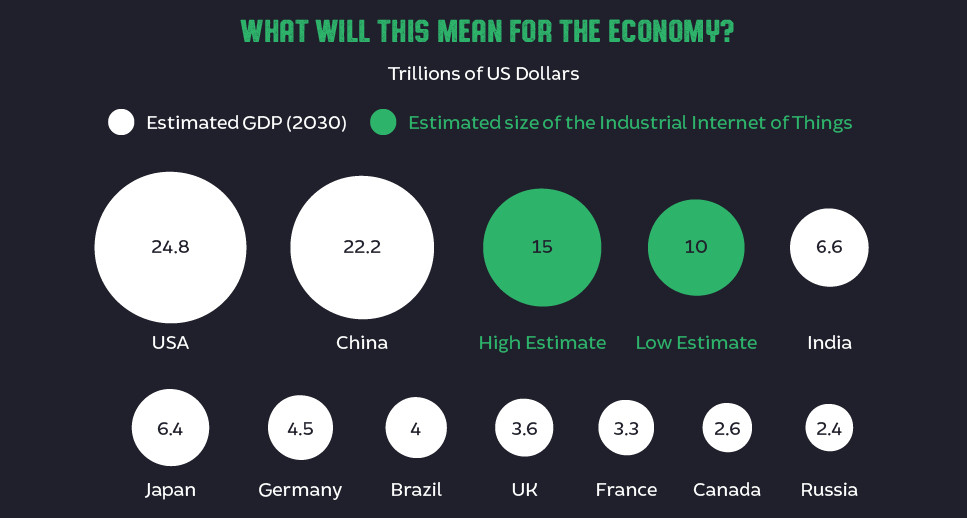The Industrial Internet of Things as the Next Big Growth Driver?
The Internet of Things (IoT) is often marketed as a consumer-based technology phenomenon that will combine the potential of low-cost sensors and big data with wide-scale internet connectivity. The promise of this consumer-focused vision of IoT is to change how we interact with daily objects in our lives. When people talk about the IoT, they often bring up ideas such as the connected home, automobiles, or health – concepts that will change how we live on a personal level. But flying under the radar is a less sexy sub-sector of the IoT that could ultimately prove to be the most transformative – the marriage of the internet of things with industrial applications such as mining, oil and gas, infrastructure, aviation, locomotives, cities, farming, manufacturing, and power generation. It’s been coined the “Industrial Internet of Things” (IIoT) by giants like GE, AT&T, Cisco, Intel, and IBM– and today’s infographic from RS Components shows that the economic growth stemming from this industrial internet revolution could be game-changing.
Industrial Internet of Things
The opportunity behind the IIoT is massive, and it’s measured in the trillions of dollars. GE, for example, expects that by 2030 that it will add $10 to $15 trillion to global GDP, and that it could raise average income significantly throughout the world.
Like previous industrial revolutions, the IIoT will allow for greater automation of previously human-intensive work, creating greater productivity per man-hour invested. Some potential applications: Smart Farming: Making use of the vast amounts of information from crop yields, soil-mapping, fertilizer applications, weather data, machinery, and animal health, to improve yields and cut costs in the modern farming environment. Smart Manufacturing: Using the industrial internet to create a fundamental shift in how products are invented, manufactured, shipped and sold. Intelligent networks will power the value chain – connecting people, processes and data and generating new best practices. Smart Cities: Cities could stand to benefit significantly from connecting people, processes, data, and things together. City assets such as libraries, transportation systems, power plants, water supply networks, waste management systems, law enforcement, hospitals and other community services could feed off each other. Local governments will understand what is happening on micro and macro levels, and how the city is evolving. Smart Energy: Power generation can be improved by combining sensors, big data, and connectivity. Imagine wind farms that make slight mechanical adjustments to capitalize on the small changes in wind velocity or direction, to be more efficient – this is only scratching the surface of what is possible. on But fast forward to the end of last week, and SVB was shuttered by regulators after a panic-induced bank run. So, how exactly did this happen? We dig in below.
Road to a Bank Run
SVB and its customers generally thrived during the low interest rate era, but as rates rose, SVB found itself more exposed to risk than a typical bank. Even so, at the end of 2022, the bank’s balance sheet showed no cause for alarm.
As well, the bank was viewed positively in a number of places. Most Wall Street analyst ratings were overwhelmingly positive on the bank’s stock, and Forbes had just added the bank to its Financial All-Stars list. Outward signs of trouble emerged on Wednesday, March 8th, when SVB surprised investors with news that the bank needed to raise more than $2 billion to shore up its balance sheet. The reaction from prominent venture capitalists was not positive, with Coatue Management, Union Square Ventures, and Peter Thiel’s Founders Fund moving to limit exposure to the 40-year-old bank. The influence of these firms is believed to have added fuel to the fire, and a bank run ensued. Also influencing decision making was the fact that SVB had the highest percentage of uninsured domestic deposits of all big banks. These totaled nearly $152 billion, or about 97% of all deposits. By the end of the day, customers had tried to withdraw $42 billion in deposits.
What Triggered the SVB Collapse?
While the collapse of SVB took place over the course of 44 hours, its roots trace back to the early pandemic years. In 2021, U.S. venture capital-backed companies raised a record $330 billion—double the amount seen in 2020. At the time, interest rates were at rock-bottom levels to help buoy the economy. Matt Levine sums up the situation well: “When interest rates are low everywhere, a dollar in 20 years is about as good as a dollar today, so a startup whose business model is “we will lose money for a decade building artificial intelligence, and then rake in lots of money in the far future” sounds pretty good. When interest rates are higher, a dollar today is better than a dollar tomorrow, so investors want cash flows. When interest rates were low for a long time, and suddenly become high, all the money that was rushing to your customers is suddenly cut off.” Source: Pitchbook Why is this important? During this time, SVB received billions of dollars from these venture-backed clients. In one year alone, their deposits increased 100%. They took these funds and invested them in longer-term bonds. As a result, this created a dangerous trap as the company expected rates would remain low. During this time, SVB invested in bonds at the top of the market. As interest rates rose higher and bond prices declined, SVB started taking major losses on their long-term bond holdings.
Losses Fueling a Liquidity Crunch
When SVB reported its fourth quarter results in early 2023, Moody’s Investor Service, a credit rating agency took notice. In early March, it said that SVB was at high risk for a downgrade due to its significant unrealized losses. In response, SVB looked to sell $2 billion of its investments at a loss to help boost liquidity for its struggling balance sheet. Soon, more hedge funds and venture investors realized SVB could be on thin ice. Depositors withdrew funds in droves, spurring a liquidity squeeze and prompting California regulators and the FDIC to step in and shut down the bank.
What Happens Now?
While much of SVB’s activity was focused on the tech sector, the bank’s shocking collapse has rattled a financial sector that is already on edge.
The four biggest U.S. banks lost a combined $52 billion the day before the SVB collapse. On Friday, other banking stocks saw double-digit drops, including Signature Bank (-23%), First Republic (-15%), and Silvergate Capital (-11%).
Source: Morningstar Direct. *Represents March 9 data, trading halted on March 10.
When the dust settles, it’s hard to predict the ripple effects that will emerge from this dramatic event. For investors, the Secretary of the Treasury Janet Yellen announced confidence in the banking system remaining resilient, noting that regulators have the proper tools in response to the issue.
But others have seen trouble brewing as far back as 2020 (or earlier) when commercial banking assets were skyrocketing and banks were buying bonds when rates were low.


















